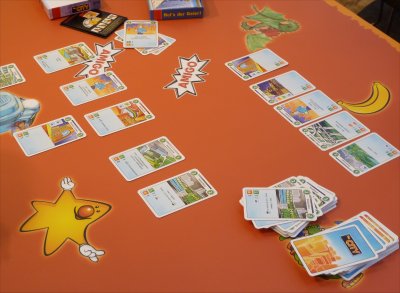![[Headline]](../technik/sonstige/headtran.gif)
![[Headline]](../technik/sonstige/headtran.gif)
![[IMAGE]](../specials/messe/essen11/ess11137.jpg) |
Author: Publisher: No. of Players: |
![[IMAGE]](../technik/box/rot/rot-3.gif) ![[IMAGE]](../technik/box/gelb/gelb-8.gif) ![[IMAGE]](../technik/box/grun/grun-3.gif) ![[IMAGE]](../technik/box/pink/pink-7.gif) ![[IMAGE]](../technik/box/blau/blau-8.gif) |
|
Over the last years AMIGO has demonstrated a good intuition for interesting cardgames, and amongst their small-boxed releases evergreens like Bohnhanza or Wizard can be found side by side with other interesting titles like Friedemann Friese's Friesematenten. This year the ranks of these games is joined by The City, a cardgame designed by Tom Lehmann, author of addictive Race for the Galaxy. Having such a well-known designer, it is no wonder that The City will be given some attention by the boardgaming public, including the fact that it has established a constant position among the top-ten games of the still running Fairplay-voting at the SPIEL '11.
Indeed, the central mechanism known from Race for the Galaxy has been recycled for The City. Thus, the game puts the players into the role of architects, and each player wants to build his own city by playing building cards from his hand. Every building card has a specific cost which must be paid in order to build it, and this payment must be made by discarding a matching amount of other building cards from the player's hand. So, the basic dilemma is once again the decision which card should be played, which cards should be kept for later, and which cards should be discarded to pay for the card played in the current turn.
 As indicated, this double use of cards is known from games like Race for the Galaxy or San Juan, but apart from this basic similarity The City operates on a reduced level of rules and playing depth. Quite the opposite, the basic structure of a turn is very straightforward, since all players simultaneously chose and reveal one card to build from their hands, and then all players pay the required building costs by discarding the appropriate number of cards from their hands. After this building phase the turn is ended by the income phase, and now every player receives an income of new building cards as depicted by the income symbols and all buildings in his city. Furthermore, each player generates an amount of victory points, and here the sum once again is depicted by corresponding symbols on the building cards within each player's city. The game gets interesting by the fact that each building belongs to up to three building categories, and these categories are business, traffic and recreational. Depending on the categories of buildings already built, the players may use the special effects depicted on some of their buildings to create nice windfall effects. So, as an example a Motorway Interchange will generate one card income plus one victory point for each traffic related symbol on a player's buildings, or a City Villa will create additional victory points for each additional City Villa within the player's city. Other cards like the Research Center bring a reduction in building costs for certain other cards, and even other buildings have a building prerequisite which must be met. So, for example, a School only can be built if a City Villa or another housing-type card can be found within the player's city. ![[IMAGE]](../bilder/thecity1.jpg) As can be seen, there are some interrelations between the different building cards, and a small minority of cards even takes cards found in other player's cities into consideration. So, for example a Subway Network generates one victory point not only for every recreational symbol found on the player's own buildings, but in addition for every recreational symbol found on buildings owned by one other player. However, apart from these very superficial relations all players work on their own, and so there is no real interaction between the players and their individual cities. As an interesting observation, the reduced scale of The City seems to make a higher level of interaction expendable. The game is played until the round when at least one player has accumulated 50 victory points, and the player with most points at the end of this round will be declared winner. On the relatively short way towards this aim (approximately 20 minutes playing time), the players seem to be perfectly happy with the optimization task they are facing within their own city. Competition is fired by the fact that the game runs over a very limited number of turns, and so the players are satisfied by simply watching the progress made by the others and deciding whether it could be wise to wait for the possibility to play a costly but valuable building or whether a more direct approach with cheaper buildings might be wiser. Thus, despite the initial differences, The City offers a playing rhythm which is comparable even to its bigger brother Race for the Galaxy. It compensates a reduced playing depth with a much easier playability especially for newcomers, and even seasoned veterans of build-and-development games should enjoy this fast-paced newcomer because of the refreshing approach chosen for a well-known topic. In a way, the The City is much more earthbound than its intergalactic brother, but due to the very reduced scale the approach chosen offers a high attractiveness on its own. All in all, a very interesting game for a quick interlude between two meaty titles or for adding a nutshell building-game to your holiday luggage. | ||
|
| ||

|
|

|
|
| ||
|
Impressum / Contact Info / Disclaimer Kulkmann@aol.com
Copyright © 2011 Frank Schulte-Kulkmann, Essen, Germany | ||